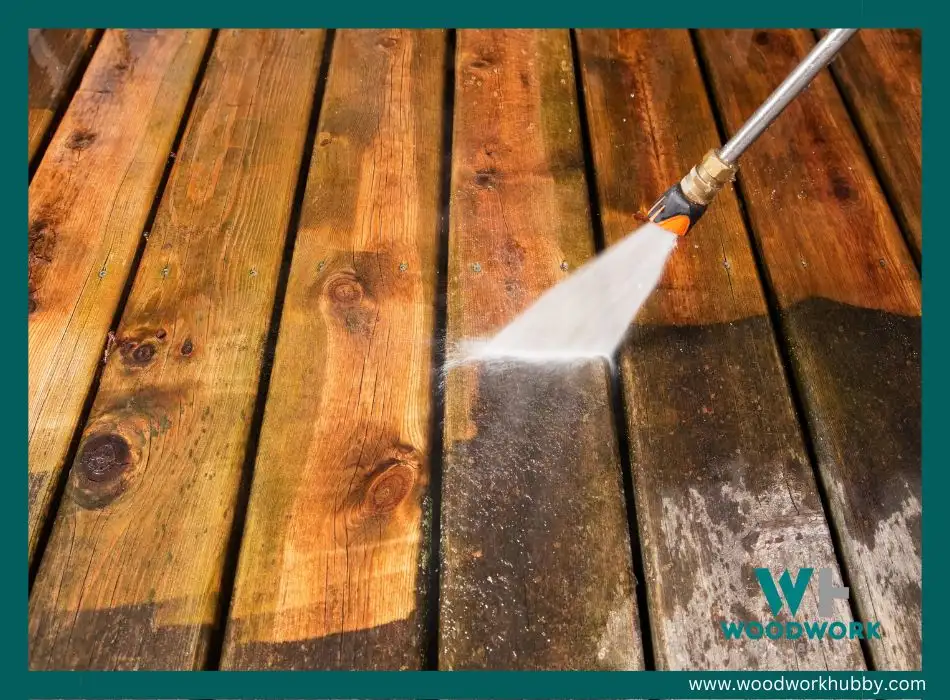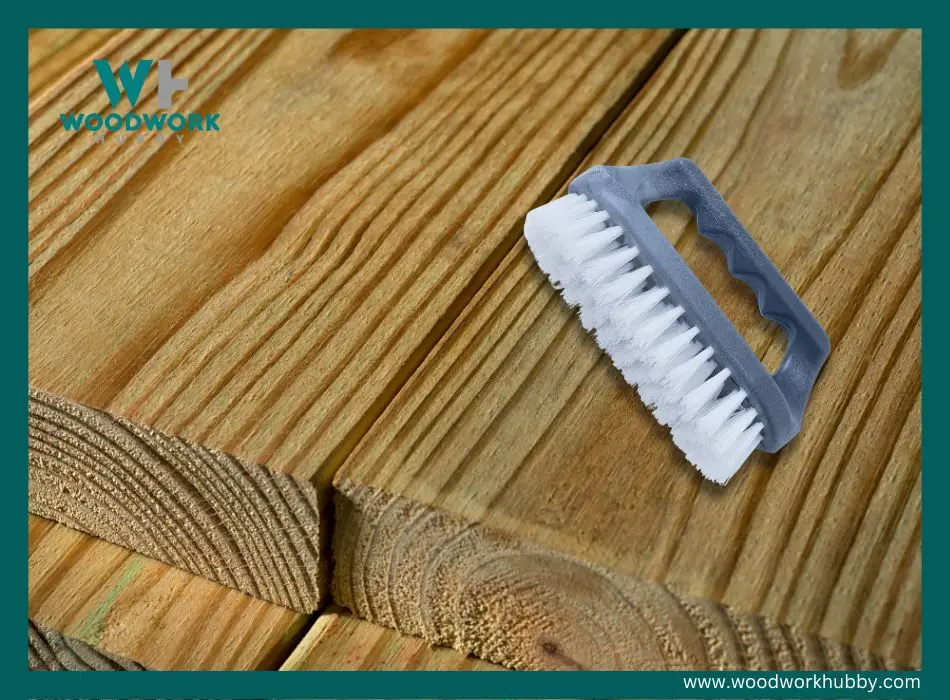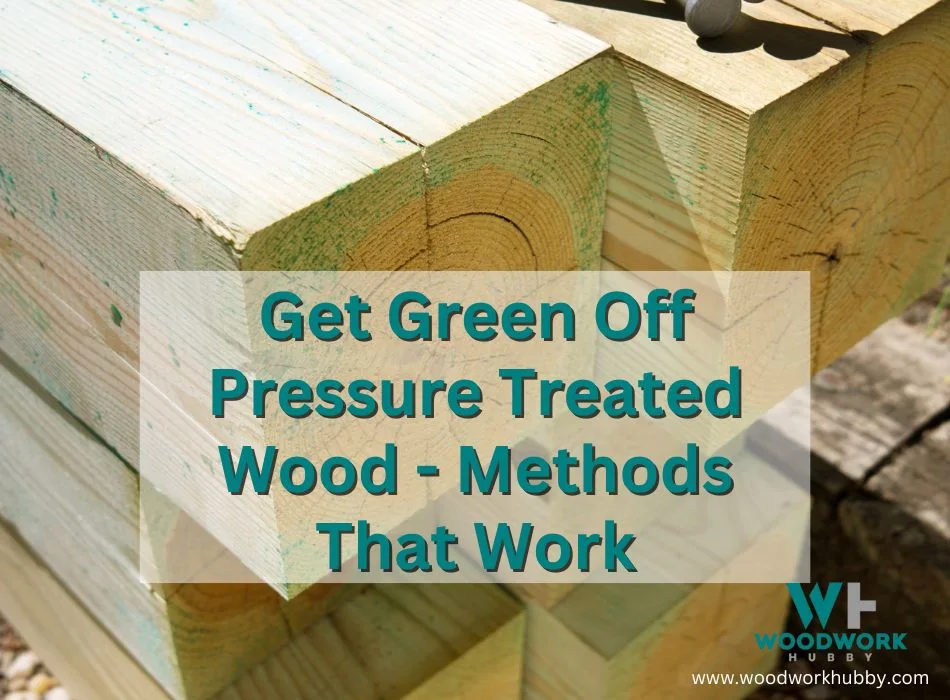Pressure-treated wood is a popular choice for decking, fencing, and outdoor structures due to its durability and extended lifespan. However, I find the unsightly green algae to be unsightly so I went in search of the perfect methods to get green off pressure treated wood.
In this blog post, You’ll discover what I found to work best and I’ll explore the causes of algae growth and provide you with effective methods for removing it from your wooden surfaces.
Key Takeaways
- Green algae growth on pressure-treated wood is caused by accumulated debris, shade, moisture, poor ventilation, and infrequent cleaning.
- Removing green algae from pressure-treated wood is important for maintaining its appearance and preventing safety hazards such as slippery surfaces.
- Effective methods for removing green algae include using white vinegar, a pressure washer, hydrogen peroxide, deck cleaners, and applying a sealer to prevent future growth.
- Regular maintenance practices like sealing the wood surface can help prevent future algae growth and maintain the integrity of your pressure-treated wood structures or surfaces.
What Is Green Algae On Pressure-Treated Wood?
Green algae on pressure-treated wood is a common occurrence caused by microorganisms that thrive in moist, shady environments and feed off the nutrients found in wood fibers.

Causes For Algae Growth On Pressure-Treated Wood
There are several factors that contribute to the growth of green algae on pressure-treated wood, making it essential to identify and address them in order to protect and maintain your wooden surfaces. Some of the primary causes for algae growth on pressure-treated wood include:
- Accumulated debris: Leaves, dirt, dust, and other debris on the wood’s surface can obstruct sunlight, creating a favorable environment for algae growth.
- Shade: Wooden areas under large structures or trees are at a higher risk of algae growth due to the limited sunlight exposure.
- Moisture: Wet or rainy weather conditions, particularly during or after winter seasons, contribute to increased moisture on the wood’s surface, making it more susceptible to algae development.
- Poor ventilation: Inadequate airflow around your wooden surfaces can encourage moisture accumulation and promote green algae growth.
- Infrequent cleaning and maintenance: Neglecting regular upkeep of your pressure-treated wood surfaces allows green algae spores to take hold and proliferate over time.
By being aware of these contributing factors, you can better protect your pressure-treated wood from unwanted green algae growth and ensure its longevity.
Importance Of Removing Green Algae From Pressure-Treated Wood
Addressing the issue of green algae on pressure-treated wood is essential for several reasons. Firstly, it maintains the aesthetic appeal of your wooden structures and surfaces.
Aside from its impact on appearance, green algae can also compromise the safety and longevity of your pressure-treated wood. For instance, when left unchecked, this unwanted intruder can make surfaces slippery and hazardous to walk on – especially in cases where it covers stairs or ramps.
Moreover, green algae may cause damage to the structure of your pressure-treated wood over time. The persistent moisture provided by these organisms encourages rotting and decay within the wood fibers themselves.
Top Methods To Remove Green Algae From Pressure-Treated Wood
There are several effective methods to remove green algae from pressure-treated wood, including using white vinegar, a pressure washer, hydrogen peroxide, and deck cleaners.
Using White Vinegar
One of the most popular and eco-friendly methods for removing green algae from pressure-treated wood is by using white vinegar. Here’s how you can effectively use this natural cleaner:

- Mix equal parts of white distilled vinegar and water in a bucket or spray bottle.
- Apply the solution to the affected area, ensuring it is thoroughly soaked.
- Allow the vinegar mixture to sit on the surface for about 15 – 20 minutes.
- Use a soft – bristle brush to gently scrub away the loosened green algae, being careful not to damage the wood fibers.
- Rinse off the treated area with clean water, making sure all vinegar residue is removed.
- Allow the wood surface to dry completely before applying any sealers or stain treatments.
- If necessary, repeat these steps until all green algae are gone.
Remember that it’s important to test this cleaning method on a small inconspicuous area first, as this ensures it won’t cause any damage to your pressure-treated wood’s appearance or structure.
Using A Pressure Washer
One of the most effective methods to remove green algae from pressure-treated wood is by using a pressure washer. This machine can be rented or purchased from a hardware store, and it uses high-pressure water to get rid of dirt and grime. Here are the steps to follow when using a pressure washer:

- Start by removing all furniture, planters, and other items from the deck.
- Sweep away any loose debris and dirt, including leaves and twigs.
- Connect your pressure washer to an outdoor water source and turn it on.
- Begin cleaning your deck by starting at one end and moving slowly in a back-and-forth motion.
- Keep the nozzle of the pressure washer at least six inches away from the surface of the wood to prevent damage.
- Once you have covered each section of the deck, rinse thoroughly with clean water while still keeping the nozzle at least 6 inches away from the wood.
Using a pressure washer can be an excellent way to remove green algae, but it is important to use it carefully to avoid damaging your deck’s surface. Make sure you follow all safety instructions when operating this tool!
Video showing how to remove algae from a deck
Trying Hydrogen Peroxide
One effective method for removing green algae on pressure-treated wood is by using hydrogen peroxide. Here are the steps to try:

- Test a small, inconspicuous area of the wood first to ensure it can withstand the use of hydrogen peroxide.
- Dilute hydrogen peroxide with water in a 1: 1 ratio.
- Apply the solution onto the affected areas using a sprayer or spray bottle.
- Let the solution sit for about 15 – 20 minutes without drying out.
- Scrub the surface with a stiff brush to remove any remaining algae.
- Rinse off with water and let dry completely before applying any sealer or stain.
Remember always to wear protective gloves when handling hydrogen peroxide, and ensure proper ventilation when using this or any other chemicals for cleaning purposes.
Using A Stiff Brush
When it comes to removing green algae from pressure-treated wood, a stiff brush can be an effective tool. Here are some steps to follow when using a stiff brush:

- Choose the right type of brush for the job, such as a wire or scrub brush.
- Mix soap and water in a bucket to create a cleaning solution.
- Dip the brush into the cleaning solution and scrub the affected area vigorously.
- Pay close attention to any grooves or cracks where algae may be hiding.
- Rinse the area thoroughly with clean water.
- Repeat steps 3 – 5 as necessary until all algae is removed from the wood surface.
- Allow the wood to dry completely before sealing or staining.
Using a stiff brush may require some elbow grease, but it can be an effective and affordable way to remove green algae from pressure-treated wood. It also allows you to avoid using harsh chemicals on your wooden surfaces while still achieving excellent results.
Utilizing Chlorine Bleach
Chlorine bleach is a powerful and effective way to remove green algae from pressure-treated wood. However, it should be used with caution on softwood and in high amounts as it can damage the wood fibers. Here are some important points to keep in mind when using chlorine bleach for algae removal:
- Dilute the bleach solution according to instructions and always wear protective gear like gloves and goggles.
- Test the solution on a small area of the wood first to avoid potential damage.
- Apply the solution with a brush or sprayer, then let it sit on the wood for 10 to 15 minutes before rinsing thoroughly with water.
- Rinse surrounding plants and vegetation before and after using bleach as it can harm them.
- Chlorine bleach should not be used on colored or painted surfaces, as it may strip away the color or cause discoloration.
Remember that chlorine bleach is just one of many methods available for removing green algae from pressure-treated wood. Choosing the appropriate method will depend on the type of wood, severity of growth, and personal preference.Regular maintenance practices such as cleaning and sealing can also prevent future algae growth.
Applying A Deck Cleaner
Deck cleaners are specially designed to remove stubborn stains and dirt from wooden surfaces, including pressure-treated wood. Here’s how you can use a deck cleaner to remove green algae from pressure-treated wood:
- Choose the right deck cleaner for your particular type of wood.
- Mix the solution as directed on the package using water and apply it to the affected area using a garden sprayer or brush.
- Allow the deck cleaner to sit on the surface for the recommended amount of time (usually 10 – 20 minutes).
- Use a stiff brush or power washer to scrub away any remaining algae and dirt.
- Rinse off the deck cleaner thoroughly with clean water.
- Apply a wood brightener as directed to restore brightness if necessary.
Deck cleaners are effective in removing green algae from pressure-treated wood because they contain powerful cleaning agents that penetrate deep into the wood fibers, breaking down dirt and grime that may have accumulated over time.
Additionally, deck cleaners are safe for use on stained or sealed surfaces, which means that you can use them without compromising your wood’s protective coating.
Regular use of deck cleaners can help prevent green growth on pressure-treated wood by keeping surfaces clean and free of moisture and debris buildup.
It is important to choose a high-quality product that is appropriate for your specific needs and always follow manufacturer instructions carefully when applying these products to avoid any potential damage to your pressure-treated wood.
Preventing Future Algae Growth On Pressure-Treated Wood
To prevent future algae growth on pressure-treated wood, apply a sealer and clean regularly with natural cleaners such as borax or detergent, inspect the wood for damage, and store it correctly to avoid moisture buildup.
Applying A Sealer
An effective way to prevent future algae growth on pressure-treated wood is to apply a sealer. Sealing the wood forms a protective layer that repels moisture, debris and fungi growth. Here are some tips for applying a sealer:
- Clean the wood surface thoroughly before applying the sealer.
- Choose a high-quality water-repellent sealant that is specifically designed for pressure-treated wood.
- Apply the sealer using a paintbrush, roller, or sprayer, following the manufacturer’s instructions.
- Allow the first coat of sealer to dry completely before applying a second coat for best results.
- Reapply the sealer every 1 – 2 years to maintain its protection.
Remember that sealing your pressure-treated wood not only helps prevent algae growth but also extends its lifespan by protecting against weathering and rotting.
Cleaning Regularly
Cleaning pressure-treated wood regularly is crucial to preventing future algae growth. It involves removing any dirt, debris, and other substances that accumulate on the wood’s surface and creating a favorable environment for algae growth. Here are some tips for cleaning pressure-treated wood regularly:
- Sweep or blow away any debris or leaves from the surface of the wood.
- Use a mild detergent and a soft-bristled brush to scrub the surface of the wood gently. Rinse thoroughly with water.
- Avoid using high-pressure washing equipment, as it can damage the wood’s surface.
- If you have a stubborn stain or have not cleaned your deck in some time, use an outdoor cleaner specifically designed for pressure-treated wood to eliminate stains and prevent future staining.
- Always wear protective gear when working with cleaning solutions and avoid inhaling fumes or getting them on your skin.
Cleaning regularly helps keep the pressure-treated wood looking fresh and new while also preventing mold, mildew, and other types of algae from damaging its structure over time. By following these simple steps, you can maintain your pressure-treated wood’s durability and appearance for years to come.
Inspecting For Damage
As a responsible homeowner, it is vital to inspect your pressure-treated wood regularly. Here are some steps to follow when inspecting for damage:
- Look for cracks and splinters: The buildup of moisture and debris can weaken pressure-treated wood, leading to cracking and splintering. Checking for cracks and splinters regularly can help identify damage early on.
- Check for discoloration: Pressure-treated wood that has been discolored may indicate the presence of green algae or other types of fungi. Discoloration can also be a sign of water damage or excessive sunlight exposure.
- Inspect for soft spots: Soft spots on pressure-treated wood indicate the presence of rot caused by fungal growth or decay.
- Examine the hardware: Nails, screws, and other hardware used in conjunction with pressure-treated wood can accelerate corrosion. Regularly checking these pieces of hardware can help prevent structural damage caused by loose connections.
- Test the strength: It is crucial to check the strength of your pressure-treated wood periodically. This helps you identify weak spots that could cause accidents.
By following these steps during regular inspections, you can catch any potential issues with your pressure-treated wood early on and take necessary measures to repair them before they become more significant problems down the line.
Storing Correctly
As someone who has worked with pressure-treated wood for many years, I understand how important it is to store it correctly to prevent staining and damage. Here are some tips on storing your pressure-treated wood properly:
- Store your wood in a clean, dry location.
- Keep the wood off the ground by using a pallet or other raised platform.
- Cover the wood with a tarp or plastic sheeting to protect it from rain and moisture.
- Make sure there is adequate ventilation around the stored wood to prevent mold and mildew growth.
- If storing the wood for an extended period, rotate it periodically to ensure even drying and prevent warping or twisting.
By following these simple steps, you can prolong the life of your pressure-treated wood and prevent future staining and damage caused by excessive moisture or debris buildup. Remember that proper storage is just one aspect of good maintenance practices, so be sure to regularly inspect and clean your wood as well.
FAQs
Are you wondering if green mold on pressure-treated wood is dangerous or can be painted over? Our FAQs section covers these topics and more to help you properly care for your wooden surfaces.
Is Green Mold On Pressure-Treated Wood Dangerous?
Green mold on pressure-treated wood may not be dangerous, but it can cause damage to the surface and pose a safety hazard. The green color is caused by algae growth due to factors such as moisture, debris accumulation, and lack of sunlight.
If left untreated, the algae can spread quickly and attract more moisture, leading to further damage and decay of the wood structure. Additionally, the slippery nature of algae-covered surfaces can increase the risk of slips and falls.
Can Green Algae Be Painted Over On Pressure-Treated Wood?
Yes, green algae can be painted over on pressure-treated wood for a permanent solution to cover up the staining and protect the wood from future damage. Painting over the stain is an effective method that provides excellent coverage while protecting the underlying wooden surface.
However, before you paint over it, make sure to remove all traces of algae from the wood with one of the cleaning methods mentioned above in this article. It’s also essential to use a high-quality primer before painting to ensure better adhesion and longevity.
Finally, use a top-quality exterior-grade paint that offers superior resistance against weather conditions such as rain, snow, or extreme temperatures.
Final Thoughts – How To Get Green Off Pressure Treated Wood
Overall, removing green algae from pressure-treated wood is a crucial step in preserving its structural integrity and maintaining its appearance. DIY methods such as white vinegar, hydrogen peroxide, and a stiff brush can be effective solutions for light green algae stains.
For more severe cases of staining, chlorine bleach, and deck cleaners are viable options. Painting over the stain provides a long-lasting solution to cover up the green algae completely.
Proper maintenance, cleaning regularly, inspecting for damage, and storing correctly can prevent future growth of green algae on pressure-treated wood.
FAQs:
1. What causes green algae or mold to grow on pressure-treated wood?
Green algae and mold typically grow on pressure-treated wood when it is exposed to moisture for a prolonged period of time. This can happen when the wood is in contact with soil, or if there isn’t proper ventilation around the structure.
2. What are some methods for removing green from pressure-treated wood?
One effective method for removing green from pressure-treated wood is by using a solution of water and bleach, which should be applied using a scrub brush or power washer. Another option is using specialized cleaning products designed specifically for this purpose.
3. Is it safe to use bleach to clean pressure-treated wood?
Yes, bleach can be used safely as long as it’s diluted properly – usually one part bleach to nine parts water should suffice – and any nearby plants or vegetation are covered before application. Additionally – wearing protective clothing such as gloves & goggles while working around chemicals ensures accidental exposure doesn’t occur.
4. How often should I clean my pressure-treated deck or structure?
It’s recommended that you clean your pressure-treated deck at least once per year using one of the above-mentioned methods depending upon the severity/extent of staining/discoloration etc but may require more frequent attention in particularly humid/wet climates where fungus/mold growth occurs more frequently than other regions.
Regularly sweeping debris off surfaces also helps prevent build-up over time which could lead to unwanted issues later on (decay, deterioration).




